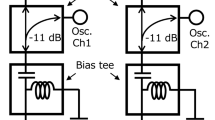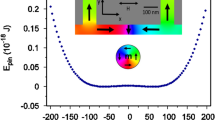Abstract
Spin torque oscillators (STOs) feature transient non-linear behaviour that can be exploited for computation. When combined in arrays, they can be networked to produce more complex collective behaviours than single devices alone. We simulate a physical reservoir computer comprising an array of STOs, using a macro spin approximation. We demonstrate that STOs can be networked together in arrays using nanowires, and that by altering the properties of these nanowires we can optimise the magnetic exchange coupling between the oscillators for computational purposes. We train a simulated array of coupled oscillators to compute various time-independent and time-dependent benchmark tasks. We explore the effects of array size, heterogeneous coupling, and connection topologies. We demonstrate the computational potential of programming the exchange coupling in arrays of oscillators through nanowires.
Access this chapter
Tax calculation will be finalised at checkout
Purchases are for personal use only
Similar content being viewed by others
Notes
- 1.
available from https://data.world/data-society/pima-indians-diabetes-database.
References
Appeltant, L., et al.: Information processing using a single dynamical node as complex system. Nature Commun. 2, 468 (2011). https://doi.org/10.1038/ncomms1476
Atiya, A.F., Parlos, A.G.: New results on recurrent network training: unifying the algorithms and accelerating convergence. IEEE Trans. Neural Netw. 11(3), 697–709 (2000). https://doi.org/10.1109/72.846741
Berger, L.: Emission of spin waves by a magnetic multilayer traversed by a current. Phys. Rev. B 54, 9353–9358 (1996)
Checinski, J.: Synchronization properties and reservoir computing capability of hexagonal spintronic oscillator arrays. J. Magn. Magn. Mater. 513, 167251 (2020)
Chen, T., et al.: Comprehensive and macrospin-based magnetic tunnel junction spin torque oscillator model- part I: analytical model of the MTJ STO. IEEE Trans. Electron Devices 62(3), 1037–1044 (2015). https://doi.org/10.1109/ted.2015.2390411
Dale, M., O’Keefe, S., Sebald, A., Stepney, S., Trefzer, M.A.: Reservoir computing quality: connectivity and topology. Natural Comput. 20(2), 205–216 (2020). https://doi.org/10.1007/s11047-020-09823-1
Dale, M., et al.: Reservoir computing with thin-film ferromagnetic devices (2021), arXiv:2101.12700 [cs.ET]
Dale, M., Miller, J.F., Stepney, S., Trefzer, M.A.: Reservoir computing in material substrates. In: Nakajima, K., Fischer, I. (eds.) Reservoir Computing. NCS, pp. 141–166. Springer, Singapore (2021). https://doi.org/10.1007/978-981-13-1687-6_7
Dua, D., Graff, C.: UCI machine learning repository (2019), http://archive.ics.uci.edu/ml
Evans, R., Coopman, Q., Devos, S., Fan, W., Hovorka, O., Chantrell, R.: Atomistic calculation of the thickness and temperature dependence of exchange coupling through a dilute magnetic oxide. J. Phys. D Appl. Phys. 47(50), 502001 (2014)
Fukushima, A., Seki, T., Yakushiji, K., Kubota, H., Yuasa, S., Ando, K.: Spin dice: random number generator using current-induced magnetization switching in mgo-mtjs. SSDM2010 Extend. Abstract pp. 1128–1129 (2010)
Furuta, T., et al.: Macromagnetic simulation for reservoir computing utilizing spin dynamics in magnetic tunnel junctions. Phys. Rev. Appl. 10(3), 034063 (2018)
Tetko, I.V., Kůrková, V., Karpov, P., Theis, F. (eds.): ICANN 2019. LNCS, vol. 11731. Springer, Cham (2019). https://doi.org/10.1007/978-3-030-30493-5
Gilbert, T.: Classics in magnetics a phenomenological theory of damping in ferromagnetic materials. IEEE Trans. Magn. 40(6), 3443–3449 (2004). https://doi.org/10.1109/tmag.2004.836740
Grollier, J., Querlioz, D., Camsari, K., Everschor-Sitte, K., Fukami, S., Stiles, M.D.: Neuromorphic spintronics. nature. Electronics 3(7), 360–370 (2020)
Harvey, I.: The microbial genetic algorithm. In: Kampis, G., Karsai, I., Szathmáry, E. (eds.) ECAL 2009. LNCS (LNAI), vol. 5778, pp. 126–133. Springer, Heidelberg (2011). https://doi.org/10.1007/978-3-642-21314-4_16
Jaeger, H.: The echo state approach to analysing and training recurrent neural networks – with an erratum note. Bonn, Germany: German National Research Center for Information Technology GMD Technical Report 148(34), 13 (2001)
Kanao, T., Suto, H., Mizushima, K., Goto, H., Tanamoto, T., Nagasawa, T.: Reservoir computing on spin-torque oscillator array. Phys. Rev. Appl. 12(2), 024052 (2019)
Kawai, Y., Park, J., Asada, M.: A small-world topology enhances the echo state property and signal propagation in reservoir computing. Neural Netw. 112, 15–23 (2019)
Khvalkovskiy, A., et al.: Basic principles of STT-MRAM cell operation in memory arrays. J. Phys. D Appl. Phys. 46, 074001 (2013)
Locatelli, N., Cros, V., Grollier, J.: Spin-torque building blocks. Nature Mater 13(1), 11–20 (2014)
Lukoševičius, M.: A practical guide to applying echo state networks. In: Montavon, G., Orr, G.B., Müller, K.-R. (eds.) Neural Networks: Tricks of the Trade. LNCS, vol. 7700, pp. 659–686. Springer, Heidelberg (2012). https://doi.org/10.1007/978-3-642-35289-8_36
Maekawa, S., Valenzuela, S.O., Kimura, T., Saitoh, E.: Spin Current. Oxford University Press (2017)
Marković, D.: Reservoir computing with the frequency, phase, and amplitude of spin-torque nano-oscillators. Appl. Phys. Lett. 114(1), 012409 (2019)
Meo, A., Cronshaw, C.E., Jenkins, S., Winterburn, A., Evans, R.F.L.: Spin-transfer and spin-orbit torques in the Landau-Lifshitz-Gilbert equation (2022). 10.48550/arXiv.2207.12071
Naz, H., Ahuja, S.: Deep learning approach for diabetes prediction using PIMA Indian dataset. J. Diabete Metab. Disord. 19(1), 391–403 (2020). https://doi.org/10.1007/s40200-020-00520-5
Prenat, G., Dieny, B., Guo, W., El Baraji, M., Javerliac, V., Nozieres, J.: Beyond MRAM, CMOS/MTJ integration for logic components. IEEE Trans. Magn. 45(10), 3400–3405 (2009)
Riou, M., et al.: Neuromorphic computing through time-multiplexing with a spin-torque nano-oscillator. In: 2017 IEEE International Electron Devices Meeting (IEDM). pp. 36.3.1–36.3.4 (2017)
Romera, M., et al.: Vowel recognition with four coupled spin-torque nano-oscillators. Nature 563(7730), 230–234 (2018)
Sato, R., Kudo, K., Nagasawa, T., Suto, H., Mizushima, K.: Simulations and experiments toward high-data-transfer-rate readers composed of a spin-torque oscillator. IEEE Trans. Magn. 48(5), 1758–1764 (2012)
Sharma, R., et al.: Electrically connected spin-torque oscillators array for 2.4 GHz wifi band transmission and energy harvesting. Nature Commun. 12(1), 1–10 (2021)
Stepney, S.: Non-instantaneous information transfer in physical reservoir computing. In: Kostitsyna, I., Orponen, P. (eds.) UCNC 2021. LNCS, vol. 12984, pp. 164–176. Springer, Cham (2021). https://doi.org/10.1007/978-3-030-87993-8_11
Tanaka, G., et al.: Recent advances in physical reservoir computing: a review. Neural Netw. 115, 100–123 (2019)
Tannous, C., Gieraltowski, J.: The Stoner-Wohlfarth model of ferromagnetism: Static properties. arXiv preprint physics/0607117 (2006)
Terris, B.: Bit patterned magnetic recording media. In: Buschow, K.H.J., et al. (eds.) Encyclopedia of Materials: Science and Technology, pp. 1–6. Elsevier (2011)
Torrejon, J., et al.: Neuromorphic computing with nanoscale spintronic oscillators. Nature 547(7664), 428–431 (2017)
Tsunegi, S., et al.: Physical reservoir computing based on spin torque oscillator with forced synchronization. Appl. Phys. Lett. 114(16), 164101 (2019)
Wolf, S.A., et al.: Spintronics: a spin-based electronics vision for the future. Science 294(5546), 1488–1495 (2001)
Zahedinejad, M., et al.: CMOS compatible W/CoFeB/MgO spin Hall nano-oscillators with wide frequency tunability. Appl. Phys. Lett. 112(13), 132404 (2018)
Acknowledgements
MD, SS, and AS acknowledge funding from the SpInspired project, EPSRC grant EP/R032823/1. We thank Jed Bye for performing the preliminary coupling simulations of Sect. 2.2. All experiments were carried out using the University of York’s Super Advanced Research Computing Cluster (Viking).
Author information
Authors and Affiliations
Corresponding author
Editor information
Editors and Affiliations
A Benchmark Tasks
A Benchmark Tasks
1.1 A.1 Spiral Classification
This task involves the nonlinear classification of two spirals in Cartesian space. The dataset consists of 400 data points describing samples taken from two spirals with random noise added. The task is to classify which spiral each sample belongs to using only the (x, y) Cartesian coordinates. The spiral classes are encoded as two outputs and the predicted class is chosen as the output with highest value via a softmax function.
1.2 A.2 PIMA Indians Diabetes Classification
This datasetFootnote 1 contains real-world data related to medical diagnosis. The objective of the dataset is to diagnostically predict whether or not a patient has diabetes, based on certain diagnostic measurements. The dataset consists of several independent medical predictors including the BMI, blood pressure, and age of females at least 21 years old of Pima Indian heritage.
The database consists of 768 records. There are 268 positive and 500 negative classes. Each class is one-hot encoded into separate reservoir outputs. All input features (e.g., age) are normalised within [0, 1] before use. The training set consists of 75% of samples, and test set 25%. Each sample is randomly chosen from the database and each set maintains the same percentage of each class, respectively.
1.3 A.3 NARMA-10
The NARMA (nonlinear autoregressive moving average) task [2] evaluates a reservoir’s ability to model a 10-th order non-linear dynamical system. The task contains both non-linearity and a long-term dependency created by the 10-th order time-lag. The task is to predict the output \(y(n+1)\) given by eq.(2) when supplied with \(u(n)\) from a uniform distribution of interval [0, 0.5]. For the 10-th order systems \(\alpha = 0.3\), \(\beta = 0.05\), \(\delta = 10\) and \(\gamma = 0.1\).
A total of 5,000 values are generated and split into: 3,000 training, 1,000 validation, and 1,000 test. The first 50 values of each sub-set are discarded as an initial washout period.
1.4 A.4 Japanese Vowels
The Japanese vowels dataset [9] consists of time-series data for multi-speaker classification. The data contains utterances of two Japanese vowels ‘ae’ by nine different male speakers. The dataset consists of 270 training utterances (30 utterances by 9 speakers) and 370 different utterances for testing (24–88 utterances by the same 9 speakers). Each utterance is pre-processed using linear prediction analysis into a discrete-time series of between 7–29 frames in length with twelve LPC cepstral coefficients.
Both the training and test data are randomly shuffled, because the original dataset groups each speaker into consecutive blocks. After every utterance is ran through the reservoir, the states of all nodes are concatenated for training. To decide on the final predicted speaker, a softmax function is used. This assigns a probability to each speaker, with the highest probability used to assign the predicted speaker.
Rights and permissions
Copyright information
© 2023 The Author(s), under exclusive license to Springer Nature Switzerland AG
About this paper
Cite this paper
Dale, M., Evans, R.F.L., Sebald, A., Stepney, S. (2023). Reservoir Computing with Nanowire Exchange-Coupled Spin Torque Oscillator Arrays. In: Genova, D., Kari, J. (eds) Unconventional Computation and Natural Computation. UCNC 2023. Lecture Notes in Computer Science, vol 14003. Springer, Cham. https://doi.org/10.1007/978-3-031-34034-5_5
Download citation
DOI: https://doi.org/10.1007/978-3-031-34034-5_5
Published:
Publisher Name: Springer, Cham
Print ISBN: 978-3-031-34033-8
Online ISBN: 978-3-031-34034-5
eBook Packages: Computer ScienceComputer Science (R0)




